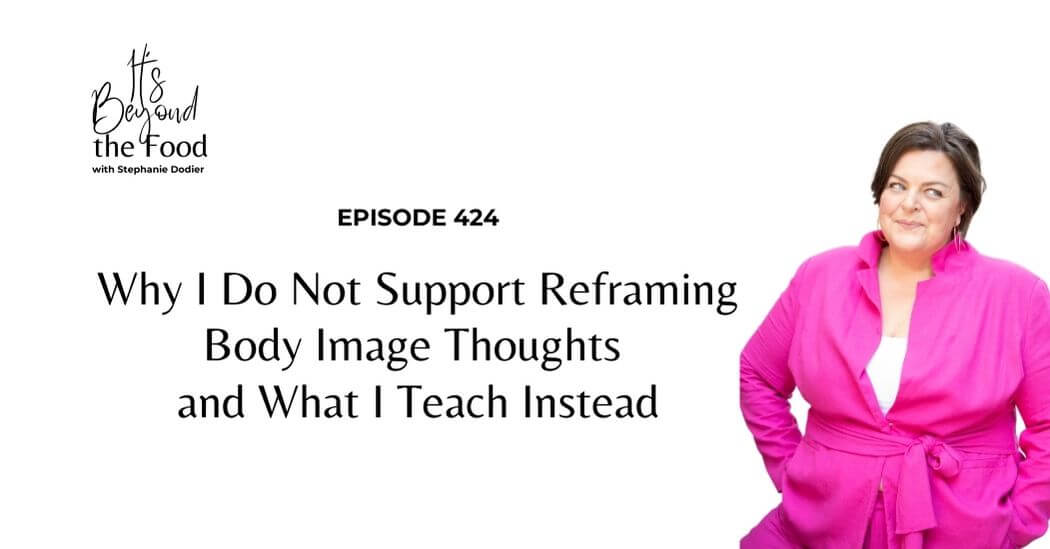

Many people believe that thought reframing is the key to healing body image struggles. But I don’t support this approach. While it may offer short-term relief, it doesn’t create lasting change.
In this episode of It’s Beyond The Food, I explain why thought reframing isn’t enough for true body image healing. Instead, I teach a deeper, more effective approach that actually changes how you think and feel about your body—for good.
What Is Thought Reframing?
Thought reframing is a technique where you replace a negative thought with a more positive one.
For example:
- “I hate my arms; they are so flabby.” → Reframed to: “I am grateful for my arms because they help me hug my loved ones.”
- “If I eat a cookie, I will gain weight.” → Reframed to: “One cookie won’t change my body.”
This method is widely used in cognitive behavioral therapy (CBT) and other coaching techniques. It’s a great first step, but it has serious limitations, especially for body image healing.
3 Reasons Why Reframing Body Image Thoughts Doesn’t Work
1. Reframing Body Image Thoughts Only Addresses One Part of Body Image
Body image is more than just thoughts. It includes:
✔ Cognitive – How you think about your body
✔ Emotional – How you feel about your body
✔ Behavioral – How you act because of your body image
✔ Physical – How you see your body
Thought reframing only addresses the cognitive aspect. It doesn’t engage with emotions or behaviors, which are crucial for long-term healing.
This is why people often feel like they are “doing the work” but not seeing real change.
2. Reframing Body Image Thoughts Can Lead to Self-Gaslighting
Thought reframing can turn into self-gaslighting when it forces you to deny your reality.
For example, if you look in the mirror and think, “I hate my body,” and someone tells you to just think positively, you might feel like your true emotions don’t matter.
Denying your feelings doesn’t heal them. Instead, it creates more distress, making you feel disconnected from yourself.
For professionals, this is a key lesson. Never deny a client’s lived experience. Instead, we must help them understand and process their feelings, not push them away.
3. Reframing Body Image Thoughts Skips the Root Cause of Body Image Struggles
Thought reframing doesn’t explore why a negative thought exists in the first place.
- Where did this thought come from?
- What belief is supporting it?
- How does this belief affect emotions and behaviors?
Without addressing the root cause, thought reframing becomes a temporary fix. It’s like putting a bandage over a deep wound without cleaning it first.
What to Do Instead: A Therapeutic Approach to Body Image Healing
Instead of just swapping thoughts, we need to take a deeper approach.
Step 1: Pause and Feel the Emotion
Before changing a thought, acknowledge the emotion behind it.
If a client feels disgust toward their body, the goal is not to make that feeling disappear. Instead, they need to process it.
A technique I use is riding the wave—a method where you allow yourself to feel an emotion without resisting it. Once you sit with an emotion, it starts to lose power.
Step 2: Investigate the Thought and Belief Behind It
Instead of immediately reframing a negative thought, ask:
- Why do I think this way?
- Where did I learn this belief?
- Does this belief actually serve me?
For example, if someone believes “My body is disgusting,” they must explore:
- Did I learn this from diet culture?
- Did someone in my life reinforce this belief?
- Is this belief based on social conditioning rather than truth?
Step 3: Decide What You Want to Believe Instead
After investigating, it’s time to consciously choose a new belief.
This is where intentional thinking comes in. Instead of forcing a new thought, we create a belief that feels realistic and empowering.
For example:
- Instead of “I love my body” (which may feel untrue), try “My body allows me to experience life.”
- Instead of “I must lose weight to be worthy,” try “My worth isn’t determined by my body size.”
This process actually rewires the brain, creating real, lasting change.
Thought Reframing vs. Intentional Thinking: The Key Difference
Thought reframing is like putting a bandage on a wound. It covers up the issue but doesn’t heal it.
Intentional thinking is like removing the root cause before healing begins. It allows you to:
✔ Understand your body image struggles
✔ Process the emotions behind them
✔ Consciously choose new beliefs that align with your values
When we approach body image healing this way, thought reframing becomes a tool, not a solution.
What You’ll Learn in This Episode on Reframing Body Image Thoughts:
- Why thought reframing isn’t enough for body image healing
- How self-gaslighting can keep you stuck in negative patterns
- The 3-step process to truly shift body image beliefs
- The difference between temporary fixes and real healing







